Gary Vaynerchuk's Blog, page 33
December 6, 2018
5 Things To Watch For the Next Economic Recession
No one knows the exact day, but I can tell you this for sure:
The economy is going to collapse. Maybe not tomorrow, maybe not next year, but we’re not going to live the rest of our lives in a bullish market.
When the economy collapses, here’s what will happen:
1. The “brand” of colleges will collapse
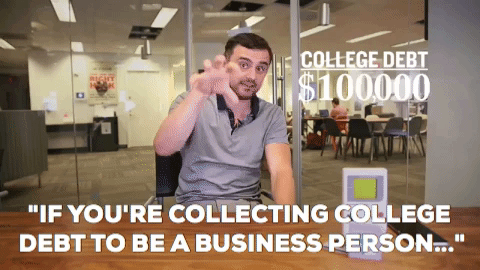
I genuinely believe that student loan debt will tear down this economy.
You’ve got so many kids who are tens of thousands, even hundreds of thousands of dollars in debt on 9% interest… making $34,000 / year… and are still getting big loans to buy apartments and cars.
I don’t know how long the economy can be artificially held up, but at some point, it’s going to hit. And it’s going to hit hard. When it does, everyone’s going to blame the colleges. The same thing that happened to the banks in 2008 will happen to colleges during the next recession, and the conversation around colleges will change.
The top schools like Harvard and Stanford might be able to hold on a little longer because of their brand, but a lot of state schools are going to be in trouble.
2. Companies will be forced to be smarter about how they spend their money
With so much money in the system, companies can get away with spending money on things like billboards and TV commercials.
But when the economy melts, big businesses will fold because they’re overleveraged… and the ones that hang on will get their marketing budgets cut massively. That means they’ll have to make $1 work like $10, and VaynerMedia will grow much faster because we’re established as knowing how to do that.
And when that happens… I’ll use the cashflow from our revenues to buy dying brands, run them through the VaynerMedia machine, flip them when the economy recovers, and buy the Jets 
December 3, 2018
How a Furniture Company Used Branding Strategies to Grow Actual Sales
VaynerMentors is our way of helping small-medium businesses (between $3M – $25M) accelerate to their next stage of growth. Kind of like McKinsey or Bain, but without the millions of dollars in fees.
It goes way beyond Facebook and Instagram tactics — we dissect your entire business from the ground up, and help you shortcut your way to explosive growth.
In this case study, our team interviewed Amanda Martin, CEO of Lindsey’s Suite Deals Furniture— a retail furniture company that used creative branding strategies to grow their business after VaynerMentors.
For some more context, check out this consultation we had with them where I get tactical on how to build brand:
This case study is super exciting for me because Amanda was also the first female CEO we worked with! Hope you enjoy 
November 29, 2018
Announcing… The GaryVee SP25
I’m so fired up to announce my newest sneaker release collaboration with K-Swiss and Shoe Palace!!
For Shoe Palace’s 25th Anniversary, we’re going to be releasing the Shoe Palace x K-Swiss “GaryVee SP25” on December 4th, 2018.

Shoe Palace is a retail company that started off as a small family business, just like Wine Library. They went from one location in the Bay Area to over 160 locations all over the country. Super excited to collaborate with a family business for my next sneaker launch!
How to get them
The Shoe Palace x K-Swiss GaryVee SP25 will be mainly available at Shoe Palace’s Palo Alto location (451 University Ave, Palo Alto CA 94301) and online at ShoePalace.com starting 12/4 – with limited quantities going to select locations around the country* (full list of locations will be added below in the future).

An invitation to my holiday party
I’m also hosting an exclusive, private holiday party in Palo Alto at the Shoe Palace location on December 11th from 5pm – 8pm PST to celebrate the release and end the year with a bang!
We’ll have some fun over food, drinks, and holiday activities. There will also be a live Q&A session with me 
November 28, 2018
3 Tips for Running a Successful Family Business
My first actual job (besides selling baseball cards and ripping people’s flowers out of their yard and selling it back to them) was bagging ice at my dad’s liquor store.
Over time, I grew it to a $60M revenue company.
I’ve learned so much from my father and working through our differences to build a meaningful family business. Here are a few tips I have for anyone interested in starting or joining a family business.
1. Practice radical candor
Radical candor is the hardest thing to do when you’re running a family business.
But it’s also the most important.
When you’re working at a job, you could have a disagreement with your boss that affects your relationship at work. But in a family business, that disagreement could bleed into your personal relationship.
For example, if you’re a young kid getting your “at-bat” in the family business, you might believe in a different way of doing things compared to your parents. You might want to spend money on social, but they want to stick to direct mail. You might believe in building a brand, but they’re stuck in “sales mode.”
The best way to convince old minds is by being radically honest about what you believe. Even if it sounds disrespectful.
Tell them they’re old. Tell them they’re out of touch. Do what you have to do to get a chance to prove yourself.
(Side note: Radical candor when telling my family about social media and marketing is a lot easier than, say, giving them negative feedback about their performance).
The dynamics in a family business make other decisions harder too.
For example, this caller, Edgar, on the AskGaryVee show once asked me how to ask for a raise in a family business.
Edgar was afraid to ask because he loves his family and doesn’t want to seem like a “leech.” But he feels he deserves more for the work he’s doing.
I loved this question because I could tell he was coming from a place of good intent. But the truth is, the best thing you can do for your family is to “get yours” first. If you feel like you deserve to get paid more but you don’t ask for it because you love your family, you’ll “crack” and resent them eventually. That’s bad for both of you, long term.
When I think about when my family and I have been at our best in business vs our worst, the biggest variable is always the number of issues we’re holding close to our chest.
2. Create boundaries around your skillset
You’ve got to have clear boundaries when it comes to what you handle running a business that your family members don’t question.
When we were starting VaynerMedia, my brother AJ knew exactly what he was good at and I knew what I was good at. If I ever crossed the line and tried to handle AJ’s role, he would get upset. If he tried to handle my role, I would get upset.
(Keep in mind that giving your opinion on how a partner should handle their role is different from actually trying to handle it yourself).
The best way to come up with responsibilities for someone new in a family business is by giving them a shot at handling something, and see how they do.
For example, if my daughter turned 23 and wanted to go into business with me, I might give her some money from our marketing budget with 1-2 employees, and tell her to run it. The way she runs it would prove whether or not she can handle that area of the business, and also act as a proxy to how good she’d be in other areas.
It’s what I did at Wine Library. When my dad gave me a shot to grow the business, I took it from $3 million to $10 million in revenue real quick. And that was the end of the debate.
3. Put love over money
Ultimately, the single biggest thing to remember in family business is to put love over business.
When building VaynerMedia, the knowledge that my brother AJ and I love each other more than we love the business got us through a lot of fights. We care more about each other than we care about “getting our way.”
For example, I made AJ a 50/50 partner in VaynerMedia even though the company started on the back of my brand. Even though I had leverage I had built with getting results for Wine Library.
I thought it was more important to start our relationship off on the right foot instead of trying to maximize my short term gains.
AJ is an incredibly self-aware person who understands my strengths, too. When we’ve gone on to start other projects like my venture fund, he came out and said I should get a bigger piece of the upside.
Putting love over business got me through some really tough times at Wine Library when I was building the business with my dad.
My dad’s an old school guy who didn’t like it when I changed my mind when it come to our strategy. He wanted to stick to decisions. He’s much more cynical than I am, and things that didn’t affect me affected him deeply.
Because of that, there was a lot of friction between us. But every time we’d argue for long periods of time, I’d default to remembering that we’re family and we love each other first. It’s been huge in maintaining the relationship.
Check out my full original film on How to Grow a Family Business:
November 16, 2018
Effective Facebook Advertising Strategies for 2019
People get confused when I talk about advertising on Facebook and Instagram.
Truth is, I don’t actually care about Facebook. I don’t care about social media.
I’d be thrilled to tell you all of you to go and buy ads on page 187 of Vogue Magazine, or buy billboard ads and outdoor media.
The only problem is… they’re massively overpriced.
People aren’t looking at billboards. They’re not paying attention to TV commercials. They’re not reading magazines. So in reaction to that low demand, those companies have increased the price of advertising to keep it ROI positive.
That means smaller companies have a few years to take advantage of these platforms before big companies start crowding in.
But first… businesses need to adapt their mindset to the “new world” of marketing.
The old world of marketing vs the new world
Look back at what happened when attention shifted from radio to television.
Businesses started running TV commercials like they’d run radio ads. There would be a man in front of there holding up an image, and there would be a narrator narrating that image. The ad wasn’t “native” to television, and there was a huge misunderstanding of what makes a ‘good’ TV commercial.
Marketers and advertisers hadn’t figured out what a commercial should look like. They were trying to adapt the “old world” into the “new world.”
We’re seeing a similar thing happen today as we move from a TV commercial, outdoor media world onto a Facebook and Instagram world.
Most people understand that you can’t just take a TV commercial and “paste” it on Facebook. We understand that doesn’t work. But there’s a more advanced conversation that we’re not having around what actually does work in a social media environment.
For example… should you be changing out actors and actresses in your videos to demographically match the customer base that you’d be targeting? Should you test your messaging by posting a tweet or a blog post first to see if it’s worth spending money on a video? How many pieces of content should you be creating for each segment?
There’s a gross misunderstanding of what it takes to win in the new world.
But those that get it are building massive businesses.
How Wish became a multi-billion dollar business
Wish is a mobile shopping app founded by engineers at Google who worked on the AdWords product.
They’re doing billions of dollars in sales, and I genuinely believe that they’re the only conceivable threat to Amazon today.
How’d they do it?
They’re nearly 100% of their money on Facebook and Instagram advertising.
The biggest companies and brands in the world are the ones who take advantage of underpriced attention the most.
For example… the biggest advertiser on Google AdWords when it was underpriced 8 years ago was Amazon. The biggest regret of my career as an entrepreneur is not spending more on wine terms when Google AdWords was underpriced.
Companies like MVMT Watches and Wish are hitting tens of millions to billions of dollars in sales by spending 100% of their budget on influencers, Facebook, and Instagram.
Meanwhile… over 90% of Fortune 500 CPG brands are declining in market share. Their primary spend is on programmatic digital advertising and TV commercials.
It’s super interesting to me what Fortune 500 companies spend their money on, versus people who need to feed their families with the money their business makes.
This is not a subjective debate. It’s what’s actually happening in the business world.
It’s why I’m pushing so many businesses to get more practical with how they make their money.
Tactics for Facebook Advertising
Here are some specific tactics you can use to run campaigns in 2019:
1. Create 20 – 100+ audience segments
I’m creating 100 pieces of content around my personal brand per day.
And I’m still probably 4,000 short of what I should be doing.
Meanwhile, there are businesses out there are creating 4 pieces of content for the year, and they’re putting massive budget behind those pieces of content.
It’s much more impactful to segment your customer base into 20 – 100 segments, and create content specifically for each of those segments. For example, I’m not a huge fan of Milky Way candy. But if they targeted me on Facebook with a piece of content tied to the New York Jets, I’m interested.
You’ll be much more likely to get a reaction from your audience if you created content contextual to who they actually are.
2. Don’t worry about high CPMs
The reason businesses are afraid to go narrow on targeting is because it increases CPMs.
But the broader you go, the more “vanilla” your messaging needs to be.
It’s why brands like Coca-Cola and Skittles have used slogans like “Open Happiness” or “Taste the Rainbow.” In the old world of marketing, it wasn’t possible to go narrow. You only had a few pieces of content that millions of people would see – so your slogan had to be vanilla.
When you go narrow, you might pay higher CPMs, but your creative has a much better shot at converting because you can tailor your message to your segment.
Too many companies are thrilled to pay lower cost for higher reach, then get confused when their creative doesn’t get anyone to do anything.
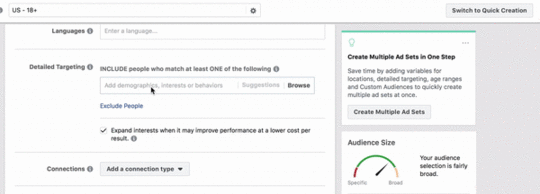
Example: Facebook brought back the feature that lets you target by employer
3. Run retargeting ads on the most engaged viewers
Here’s a winning strategy that will convince you that marketing works for the rest of your life:
Create a contextual, long form video and get 100,000+ people to see it.
Then, take viewers who watched 2-3 minutes of that video and retarget them with a call-to-action.
You’ll be stunned how many of them convert.
4. Test and learn before spending money on promotion
It’s ludicrous to me how companies decide to spend $200,000+ on creating an advertisement based on tiny focus groups and subjective opinions of internal decision makers.
There are much smarter ways to test which piece of creative to bet your money on.
For example… you could test out your messaging through a tweet or a blog post. If that works, you could make a picture that goes more in depth. If that gets traction, you could make a short video clip. If that works, expand that into something bigger.
Watch the full keynote here:
November 15, 2018
How a Beauty Company Added $100,000 / month in Revenue After VaynerMentors
VaynerMentors is VaynerMedia’s way of helping small and medium business hit a new level of growth and scale.
It’s our way of taking everything we learned working with big businesses, and using them to help smaller companies unlock their full potential.
In this case study, our team interviewed Habib Salo, CEO of Young Nails — a beauty company that added $100,000+ / month in revenue after going through VaynerMentors.
Here’s a clip from one of our meetings that can shed some light on how we operate:
Excited for you guys to read this case study. You’ll see what VaynerMentors brings to the table, and how it’s about more more than just “social media marketing.”
Click here to learn more about the program, and to apply.
When you first signed up for VaynerMentors, what did you expect?
Vayner4Ds was the first experience I had with a “VaynerMedia” program. I committed to 4Ds because of Gary’s content. I had listened to his podcast pretty regularly.
4Ds went way above and beyond my expectations. The depth of consultation and support I got from 4Ds incredible — not only did the entire team know their stuff, I also felt like they genuinely cared.
So coming into VaynerMentors, I had a very good idea of what to expect in terms of the expertise and support I’d get.
Was there anything that surprised you as you went through the program?
There were a few big takeaways that surprised me:
First thing was the amount of value that was already in our existing customer base.
For the last four years, I’ve been looking around for someone who could help me get “unstuck” in my business. We’d hit a ceiling, and just didn’t know where to go from there. Cross selling and upselling products to existing customers was a big opportunity that we just weren’t seeing, and it was almost like “how have we never thought of this before”?
Second, it was thinking outside of the box on what we could do with our business and our brand three years down the road. Incorporating things like music and art into our brand was never something we thought we could (or should) do, but we learned how that could be a useful in terms of connecting deeper with part of the market.
The third big surprise and takeaway was the social media side of things. When we came into the program, we didn’t even know what a pixel was. VaynerMentors was huge in helping us set up the technical side of things, dial in a cohesive Facebook ad strategy, and run ad campaigns.
Lastly… biggest misunderstanding of VaynerMedia is how much business strategy you guys actually bring to the table. It’s beyond what anybody would expect.
People who follow Gary’s content might think that VaynerMentors is just about social media marketing and Facebook advertising. But the truth is, it’s so much more than that.
I didn’t expect that you guys would bring such a deep level of business strategy expertise to the table. And the best part is, it’s not just an “add on” to what you guys do from a marketing standpoint. You guys are just as good at operations and strategy as you are with marketing.
You guys completely changed our business in the last three months in terms of actual sales — not just followers.
When you look at the last 6 months, what kind of growth have you seen?
We were doing around $60k / month from just one channel in our business in August of 2017.
After VaynerMentors, we dialed in a strategy to create content consistently on Facebook, Instagram, and YouTube. And we saw that number jump to $100k / month. That’s a $40k / month boost just from doing consistent daily content on those three channels.It fluctuated up to $130k over the next 10 months.
I met with Sid (Brand Manager for Gary Vaynerchuk) in June, and he gave me solid education in terms of how all of these channels work and how we should execute on them. It took a couple of weeks for us to get things dialed in.
We implemented a more sophisticated Facebook ad strategy and Instagram campaign. We got the Facebook pixel dialed in, and the catalog dialed in w/ RSS feed with website.
We ran multiple campaigns on both Facebook and Instagram — 1 targeted at customers who purchased products, 1 who added to cart but didn’t purchased, 1 targeted at users who were logged into website but never added to cart, and 1 to people who visited the site but never added to cart.
We also had a broader ad strategy around targeting people who engaged with content in the last 180 days to drive conversions at the top level.
As for revenues, things changed dramatically.
In June 2018, we did $125k. In July and August, we kept sales over $100k at an 8-20x+ return on ad spend.
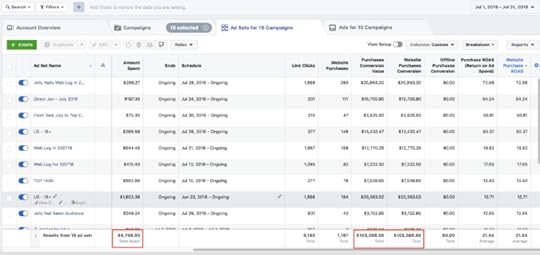

In September we did $235k across multiple channels, and in November we’re expecting to crack $300k. We never even dreamed we’d be in this position.
Staying committed to innovation in our business along with running ads on social will helped us do all this.
What was your experience working with the team? How was it different than other consulting companies you’ve worked with?
What Sabir (SVP of eCommerce at VaynerMedia) did for us in 6 hours is more than any consulting firm has ever contributed to our business. He brought so much common sense to the table, and told us how we could achieve big results by staying lean — without adding new warehouses or hiring a ton of new employees.
In addition to the fact that you guys really know your stuff, I also got the feeling that you genuinely care.
I had direct access to Sid and Sabir at all times for support — whether I had questions about a Facebook ad pixel misfiring or a deeper question about strategy. One time, I got on the phone and explained a problem I had, and Sabir was at our warehouse in 2 weeks. And all I had to do was cover travel expenses.
You don’t get that kind of care with other consulting companies — or if you do, they nickel and dime you for every cost.
With VaynerMentors, I feel a level of confidence in the future that I hadn’t felt before. I don’t have a single worry about the problems we have as we scale because I know you guys got our backs.
I feel confident that we’re going to crush our competition in the next 5 years with VaynerMentors by our side, and no other organization has ever given me that.
What would you say to someone who’s considering joining VaynerMentors but is on the fence?
Just do it.
I genuinely feel like I’ve found this big secret. It’s hard for me to contain my enthusiasm here.
If you’re considering this, just know that it’s going to be way beyond what you expect. The best part is that they actually care about you and your business.
I’ve worked with so many consulting companies in that past and when it comes down to it, they just don’t care about you. They’ll charge extra for extra questions, bill you for extra time, and just won’t be accessible in the same way VaynerMentors is.
The VaynerMentors team feels like family because of the level of access I have.
Don’t pass up the opportunity because the price of this will go up significantly in the future. It’s that good.
How VaynerMentors Can Help…
At VaynerMedia, we’ve worked incredibly hard to become world-class in areas like influencer marketing, e-commerce, emerging technology, IoT, and voice.
Normally, we take those skills to and work with big brands like PepsiCo, Mondelez, or Chase.
But eventually, we got so many requests for help from SMBs that we decided to add a new service to help them.
We genuinely believe that we could add a ton of value for businesses in the $3M – $25M range that are looking to unlock real, meaningful growth and scale.
Here’s what will happen if you get accepted to VaynerMentors:
We’ll start by dissecting your business, understanding your strengths, weaknesses, and business model. From there we’ll do a complete topline audit of your business model, organization, product, distribution, sales, marketing, advertising, paid media, creative, and operations to analyze every imaginable unlock to help you scale and grow.
We’ll put together a step-by-step growth plan specifically for you, and help you execute.
You’ll get access to our rolodex of fortune 500 companies, brands, and executives to help you scale. And you’ll have subject matter experts from our team accessible at all times.
This isn’t just about Facebook and Instagram advertising.
There’s been tremendous interest since we announced — so much that we stopped accepting new clients for 4 months. There were literally zero openings.
But now, we’re opening up applications for new clients.
Check out this page to learn more.
November 14, 2018
5 Ways You Can Help Me Celebrate My Birthday Today
This is what 43 looks like:

Today, November 14th, I turned 43 years old. And I still feel like I’m just getting started 
November 9, 2018
How to Build Great Company Culture
This is an article written by Claude Silver, Chief Heart Officer at VaynerMedia. She’s no question one of the key right hands at the company.
Culture, HR, mental health, and the excitement of my employees all matter so much to me. The decision to make Claude our Chief Heart Officer was a big one, and one that came very natural.
Excited for you to read this article 
October 29, 2018
Debating the Negative Effects of Social Media on Youth
The debate around the “dangers of social media” is such a visceral topic.
So many people are talking about how social media is damaging youth, how kids are getting “corrupted” by it, and even how it’s tearing down our democracy.
I have some pretty controversial opinions about this. On AskGaryVee Episode 296 with Baby Ariel, a concerned mother of teenage boys named Michelle asked a question about the dangers of social media and how it impacts young people. Her question was specifically about my thoughts on kids using Snapchat, but my answer applies to social media in general.
1. Social media is exposing bad parenting strategies
We’re living in an era with some of the worst parenting strategies of all time. I genuinely believe that in a hundred years, people will look back at this time and wonder what we were thinking when it comes to how we’re raising our kids.
My mom did an incredible job raising me, and I try to always use her as an example for other parents.
My mother taught me how to believe in myself the most, while still allowing me to recognize the value in others. She always supported and cheered me on for the right things, but never felt the need to award me with “8th place trophies.”
She downplayed the things that she knew didn’t matter as much for me (like school) while also teaching me to respect them at the same time. Like, I couldn’t run wild in school or curse at my teachers.
And when I did do something wrong, she gave the appropriate repercussions. She gave me the perfect mix of freedom, support, acknowledgement and most importantly, she was able to see my strengths and encouraged me to play to them.
She instilled massive amounts of self esteem in me.
Most kids aren’t so lucky. Instead of building up self esteem in kids around their strengths, a lot parents use their kids to build their own self esteem.
And it shows.
For example… a lot of parents are afraid of their kids using Snapchat because it has a rep for being a “sexting platform.” They’re afraid that their kids will get tricked by the platform and it’ll change their behavior.
But it’s not that simple.
Recently, I ripped apart a mother that I’m an acquaintance with who got very upset with my points of view on social media. I essentially told her… “maybe if you didn’t keep telling your daughter that she needed to ‘get skinnier’ when she was young, she would have better body image and wouldn’t have turned out the way she did.”
If a young girl is sending inappropriate photos to a guy in her class who gives her positive reinforcement, it’s most likely because she didn’t get that positive reinforcement at home. Not because Snapchat “made her do it.”
Another example:
A lot of kids parents complain that kids compare themselves to others on social media, and that creates insecurities in their kids. But parents are the ones comparing their kids with other kids first.
Parents are putting judgement on their kids based on how other parents view them. And because that makes the kid uncomfortable with themselves, they feel insecure when they compare themselves to others.
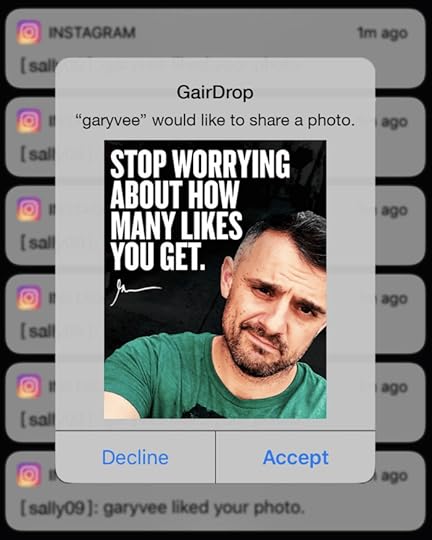
If kids are using platforms in bad ways, it’s not the platform’s fault. It’s the parenting strategies that caused that behavior to manifest in the first place.
2. Social media has been unfairly blamed for “negative effects” on society
“Such a great platform but such a bad platform, don’t you think? For example, snapchat disappears. These kids don’t understand what they’re doing.” — Michelle
In one part of our conversation, Michelle says that kids don’t understand what they’re doing, and that’s what makes platforms like Snapchat dangerous.
But in my point of view, kids will do dumb stuff regardless of the “medium.”
When I was younger, kids would “pants” each other in junior high. They would walk up behind other students, grab their pants, and pull them down in front everybody.
Kids would also steal Playboy magazines from 7-Elevens. They would rent VHS porn tapes, wait till their parents left the house, and then watch them. They would have conversations on the phone about the same sort of things they’re DM’ing each other about today.
Social media just gives kids a new platform to act out those same old behaviors.
There’s a massive, unfair demonization of new technologies when in reality, humans are acting the same as they’ve always acted.
These behaviors aren’t anyone’s fault. Everyone does dumb stuff when they’re teenagers. It’s just how humans grow.
The only difference now is, social media is exposing these behaviors to the world.
3. Most people conform to society’s definition of political correctness
If you’ve been following my content for any length of time, you know that I don’t pander to political correctness.
What’s considered “politically correct” at any moment changes.
When I first started putting out business videos years ago, I was scolded for acting the way I do. At the time, it wasn’t common for “businessmen” to curse, wear t-shirts, and get D’s and F’s in school. People thought it was unacceptable.
It was even more extreme when I was growing up. When I was in school, kids who didn’t get good grades were looked at as losers.
But now, things have changed. If you’re a D and F student in today’s environment and you’re selling stuff online, people will look at you like you’re the next Mark Zuckerberg. Now, it’s “cool” to be an entrepreneur.
I don’t pander to political correctness because it’s not a good “north star” of what’s true.
But so many parents are parenting their kids based off of the current state of political correctness in society. Personally, I don’t care whether my kids get suspended from school. I don’t care whether or not they get A’s in class.
The bigger question for me is, what’s the intent behind their actions? How are my kids treating others? Who will they grow up to become in the grand scheme of things?
To me, that’s what’s important.
October 26, 2018
How to Turn a Bucket of $20 Thomas the Trains into $175 – Trash Talk Episode 3
Thomas the train and muglife are back at it in epsiode 3 of trash talk … where I turn your trash, into cash!
The reaction from my community so far has been phenomenal and I’m already fired up and planning for tomorrow morning’s filming of episode 4! Nothing makes me happier than seeing all the tweets and comments come in from Vaynernation out there are making a few hundred to a few thousand bucks by selling stuff on eBay:
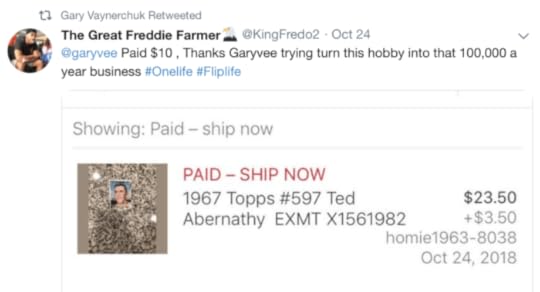


It really is stunning to me how practical it is to buy items from garage sales, resell them, and make an extra $100 – $1000 / week.
In these Trash Talk articles, I break down the highlights of the episode and try to go more in depth on the flip tactics you see on screen, so we can really eliminate excuses once and for all 




